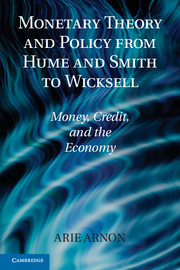Book contents
- Frontmatter
- Dedication
- Contents
- List of Illustrations
- List of Tables
- Preface
- Introduction
- Part one Analytical and Historical Foundations
- 1 Monetary Theory circa 1750David Hume
- 2 Mid-Eighteenth-Century British Financial System
- 3 Adam SmithThe Case for Laissez-Faire in Money and Banking
- 4 “Monetary Theories of Credit” in Exchange
- Part two Debating Monetary Theory under Inconvertibility
- Part three Debating
- Part four The Road to Defensive Central Banking
- Part five A New Beginning
- Bibliography
- Author Index
- Subject Index
3 - Adam SmithThe Case for Laissez-Faire in Money and Banking
Published online by Cambridge University Press: 05 July 2014
- Frontmatter
- Dedication
- Contents
- List of Illustrations
- List of Tables
- Preface
- Introduction
- Part one Analytical and Historical Foundations
- 1 Monetary Theory circa 1750David Hume
- 2 Mid-Eighteenth-Century British Financial System
- 3 Adam SmithThe Case for Laissez-Faire in Money and Banking
- 4 “Monetary Theories of Credit” in Exchange
- Part two Debating Monetary Theory under Inconvertibility
- Part three Debating
- Part four The Road to Defensive Central Banking
- Part five A New Beginning
- Bibliography
- Author Index
- Subject Index
Summary
Introduction
Adam Smith’s (1723–1790) contributions to the rise of classical economics are well known. Many consider the publication of The Wealth of Nations in 1776 to have established Smith as the founding father of the hegemonic analytical approach to the study of political economy for many years. Smith knew David Hume, who was twelve years younger than Smith; the two Scottish philosophers exchanged views on various subjects, including money, banking, and credit. Hume’s and Smith’s philosophical agreements and differences, including their mutual debts and association with Francis Hutcheson, the great Scottish enlightenment philosopher, are well recorded. As we shall see, the monetary theories of Smith and Hume, though similar in some respects, are not identical; there is enough room for interpretation to allow the secondary literature to debate their actual positions on important aspects of their theories to this day.
In the famous discussion of the “division of labor” in Book I of Inquiry into the Nature and Causes of the Wealth of Nations (as the full title runs), Adam Smith addressed money for the first time. The division of labor was at the heart of the theoretical conceptualization that Smith used in the book to explain the real growth phenomena that we know by now had changed the world. The inquiry into the theory of growth, as moderns would have called it, led Smith to conclude that “[t]he division of labour, however, so far as it can be introduced, occasions, in every art, a proportionable increase of the productive powers of labour” (p. 9).
- Type
- Chapter
- Information
- Monetary Theory and Policy from Hume and Smith to WicksellMoney, Credit, and the Economy, pp. 33 - 49Publisher: Cambridge University PressPrint publication year: 2010

